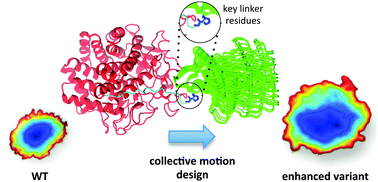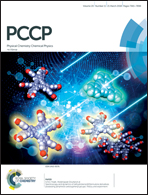Computational engineering of cellulase Cel9A-68 functional motions through mutations in its linker region†
Abstract
Microbial cellulosic degradation by cellulases has become a complementary approach for biofuel production. However, its efficiency is hindered by the recalcitrance of cellulose fibres. In this context, computational protein design methods may offer an efficient way to obtain variants with improved enzymatic activity. Cel9A-68 is a cellulase from Thermobifida fusca that is still active at high temperatures. In a previous work, we described a collective bending motion, which governs the overall cellulase dynamics. This movement promotes the approximation of its CBM and CD structural domains (that are connected by a flexible linker). We have identified two residues (G460 and P461) located at the linker that act as a hinge point. Herein, we applied a new level of protein design, focusing on the modulation of this collective motion to obtain cellulase variants with enhanced functional dynamics. We probed whether specific linker mutations would affect Cel9A-68 dynamics through computational simulations. We assumed that P461G and G460+ (with an extra glycine) constructs would present enhanced interdomain motions, while the G460P mutant would be rigid. From our results, the P461G mutation resulted in a broader exploration of the conformational space, as confirmed by clustering and free energy analyses. The WT enzyme was the most rigid system. However, G460P and P460+ explored distinct conformational states described by opposite directions of low-frequency normal modes; they sampled preferentially closed and open conformations, respectively. Overall, we highlight two significant findings: (i) all mutants explored larger conformational spaces than the WT; (ii) the selection of distinct conformational populations was intimately associated with the mutation considered. Thus, the engineering of Cel9A-68 motions through linker mutations may constitute an efficient way to improve cellulase activity, facilitating the disruption of cellulose fibres.



 Please wait while we load your content...
Please wait while we load your content...